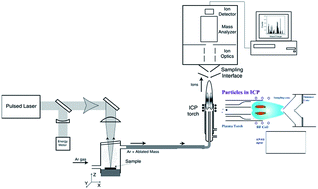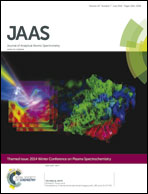Analysis of arsenic in rice grains using ICP-MS and fs LA-ICP-MS
Abstract
With rice being the main staple crop in Asian countries such as China, Korea and Japan, the detection of arsenic (As), an element known to be carcinogenic to humans, has been the topic of high public interest. In this study, the total arsenic content in 200 white and 104 brown rice samples collected in Korea was analyzed using a Quadrupole Inductively Coupled Plasma-Mass Spectrometer (ICP-MS). One of the rice grain samples was polished with 3, 5, 7, 9 and 11 degrees of milling and arsenic concentration variance from the surface to the inner core region was investigated. Furthermore, spatial distribution of arsenic over the cross-section of a brown rice grain was obtained using femtosecond Laser Ablation-Inductively Coupled Plasma-Mass Spectrometry (fs LA-ICP-MS). For the total arsenic content analysis, 91.7 ± 28.1 and 101 ± 33.6 μg−1 kg−1 of arsenic were measured in the white and the brown rice, respectively. The fs LA-ICP-MS mapping image explains that the higher arsenic concentration in the brown rice is due to high arsenic distribution in the rice husk (protective covering of rice). Consequently, some degree of rice milling may be effective in the reduction of arsenic intake.

- This article is part of the themed collection: 2014 Winter Conference on Plasma Spectrochemistry

 Please wait while we load your content...
Please wait while we load your content...